As I walked through my garden, the colors and textures of the plants amazed me. It was like a symphony of life, with each plant playing its part in a thriving ecosystem. From the ground covers that covered the soil to the tall canopy trees that gave shade, I saw the beauty of permaculture.
This guide will show you the world of permaculture plants. We’ll explore their roles and how to use them to create a lush, easy-to-care-for garden.
Key Takeaways
- Permaculture plants are key to creating thriving gardens and food forests.
- Ground cover plants help build soil, fight weeds, and add to the garden’s diversity.
- Canopy trees offer shade, control the climate, and bring many benefits.
- Having different layers of plants is vital for a strong permaculture system.
- Choosing the right plants for your climate, soil, and site is crucial for success.
Introduction to Permaculture Plants
Permaculture is a design that looks like nature. It focuses on using many different plants in a smart way. These plants help make gardens and food forests strong and able to take care of themselves.
Ground covers keep the soil healthy and stop it from washing away. They also help keep moisture in and keep weeds out. Canopy trees, on the other hand, help control the weather and provide shade. They also help keep the ecosystem balanced.
Importance of Ground Covers and Canopy in Permaculture
Ground covers protect the soil and add nutrients. They also help the soil stay moist and keep weeds away. This makes a good home for many animals.
Canopy trees are very important. They control the weather, provide shade, and help keep the ecosystem balanced. This makes the whole system work better together.
Overview of the Different Layers in Permaculture Systems
Permaculture systems have different layers, each with its own job. These layers are:
- Ground covers: Low-growing plants that form a living carpet on the soil surface
- Herbaceous layer: Edible and medicinal plants, as well as dynamic accumulators that enrich the soil
- Shrub layer: Smaller woody plants that provide food, habitat, and other ecosystem services
- Tree canopy: Tall, permanent trees that regulate the microclimate and provide a range of products and functions
By using these layers, permaculture makes systems that are like natural forests. These systems are very productive and can take care of themselves.
Ground Covers
Ground cover plants are key in permaculture, protecting soil from erosion and adding organic matter. They also help suppress weeds. You can choose from edible plants like strawberries and clover, or non-edible ones like creeping thyme. The right ground covers for your climate and site will make a low-maintenance living mulch, supporting your ecosystem.
Functions of Ground Cover Plants
Ground cover plants prevent erosion and keep soil fertile. They cover the soil, reducing water loss and keeping it cooler. These plants also sequester carbon, improve soil structure, attract wildlife, fix nitrogen, and return nutrients to the soil.
Examples of Ground Cover Plants
- In annual cultivation, legumes like Vicia faba and winter rye protect and improve the soil.
- In perennial food systems, plants like white clover and mints fix nitrogen and attract wildlife.
- In pastures, native grasses and legumes create a healthy groundcover for grazing.
- Ground cover plants can replace grass lawns with wildflower meadows or herb lawns, adding biodiversity.
Choosing the right ground cover plants is crucial. Some can become invasive if not managed. A diverse mix of ground cover plants will create a strong foundation for your productive landscape.
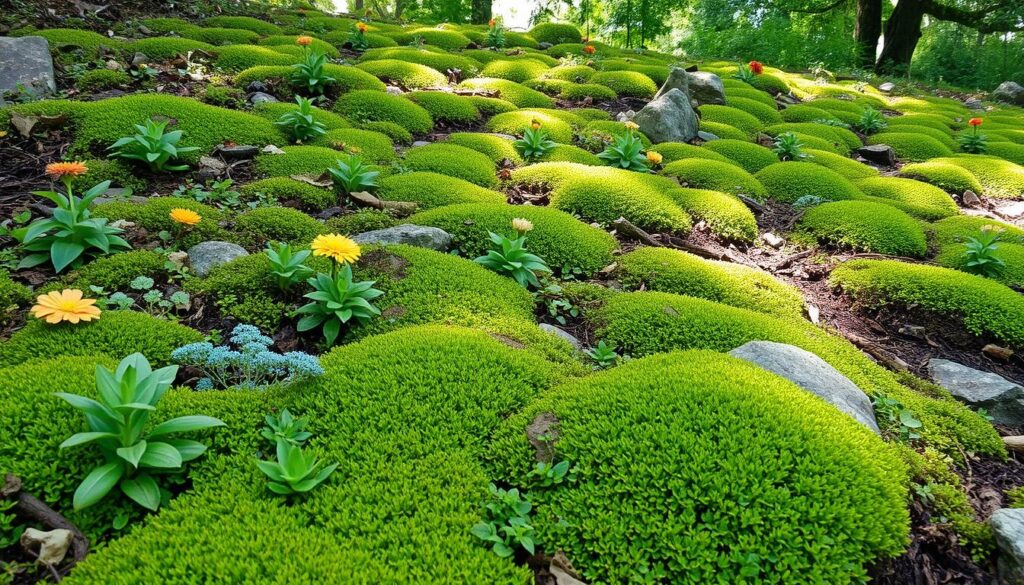
Canopy Trees
In a permaculture system, canopy trees are key to keeping things balanced and productive. These tall plants form the top layer, offering many benefits to the whole garden or forest.
Roles and Functions of Canopy Trees
Canopy trees bring many advantages to a permaculture ecosystem. They give shade, helping other plants grow well. Their roots spread out, helping with nutrient and water flow. They also attract good microbes and add to the soil with their leaves and fruits.
These trees also cool and moisten the air, slowing down wind and filtering out debris. They help with water storage and soil health, especially near water. In big farms, they can even stop land from sinking by making the soil better and holding more water.
Selecting Canopy Trees for Your Climate
Choosing the right canopy trees is important for your climate. The amount of shade needed can change with the weather. In cooler places, less shade is often better for plants.
In permaculture, Zone 5 often has the biggest canopy. Mixing different trees is key to a healthy canopy. By picking the right trees, you can make a strong and diverse food forest or garden.
“Canopy trees work constantly to repair and improve the earth, air, and water by contributing to soil building, water storage, and biodiversity.”
Permaculture Plants
Permaculture plants are key to a self-sustaining garden or food forest. These plants, like edible perennials and native species, work together. They create a strong ecosystem. By picking the right permaculture plants, gardeners can cut down on work and boost food production.
Using native species is a big part of permaculture. These plants fit well with the local climate and soil. They need less water and care than other plants. Plus, native edible perennials offer food all year, cutting down on planting and harvesting.
Drought-tolerant plants are vital in permaculture. They can handle dry spells and save water. These plants include succulents, herbs, and fruit trees, making the garden easy to care for.
Permaculture gardens often have polycultures. These are groups of plants that work together like nature does. They make the garden more productive and help many beneficial organisms, like pollinators and soil microbes.
| Permaculture Plant | Key Features | Benefits |
|---|---|---|
| Hazelnuts | Drought-tolerant, windbreak, high-calorie nuts | Provides food, shelter, and supports other plants in the guild |
| Jerusalem Artichokes (Sunchokes) | Highly resilient, minimal maintenance, low water needs | Easy to grow, nutritious tubers, and supports soil health |
| Fiddleheads | Edible, nutritious, and grow in shaded areas | Adds diversity to the garden and provides a unique food source |
By following permaculture principles and choosing the right permaculture plants, gardeners can make a thriving ecosystem. This ecosystem not only grows lots of food but also makes the environment healthier and more resilient.
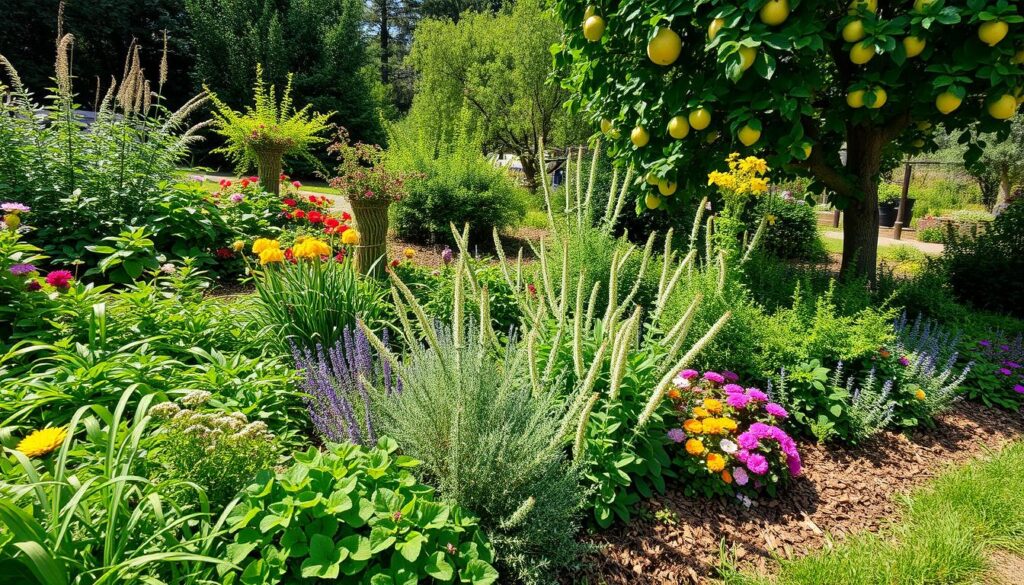
“Permaculture is a creative design process that mimics the patterns and relationships found in nature, yielding abundant food, fibre, and energy for provision of local needs.”
Layering in Permaculture Systems
Permaculture systems are designed to mimic natural ecosystems. Each layer has a key role in the system’s function and productivity. Knowing about these layers is crucial for a thriving permaculture garden or food forest.
Exploring the Permaculture Layers
The canopy layer is at the top. It has tall trees that offer shade, regulate the climate, and provide fruit, nuts, or timber. Below, the understory layer has smaller trees and shrubs, adding depth and diversity.
The ground cover layer is vital. It protects the soil, builds fertility, and prevents erosion. This layer is filled with diverse plants, from edible herbs to low-growing species that attract beneficial insects.
Vines and climbing plants occupy vertical niches. They use space and add to the system’s productivity and complexity.
The underground layer is also key. It has roots, tubers, and rhizomes that provide food and improve soil health and nutrient cycling.
https://www.youtube.com/watch?v=wjKzvvOA6Zg
By understanding and integrating these layers, permaculture practitioners can create a self-sustaining, resilient, and productive ecosystem. This ecosystem closely mimics the natural world.
Building Soil with Ground Covers and Canopy
In a thriving permaculture system, ground cover plants and canopy trees work together. Ground covers protect the soil from erosion and add organic matter. They also support beneficial soil microorganisms.
Canopy trees help by breaking up compacted soil with their deep roots. They also move nutrients from deeper layers to the surface.
The relationship between ground covers and canopy trees is key. It helps create a self-sustaining, nutrient-rich environment. By choosing the right plants, permaculture practitioners can build a thriving ecosystem.
| Ground Cover Plants | Canopy Trees |
|---|---|
|
|
By choosing the right ground covers and canopy trees, permaculture practitioners can create a rich growing environment. This environment supports long-term soil building and nutrient cycling. It’s essential for a thriving food forest or permaculture orchard.
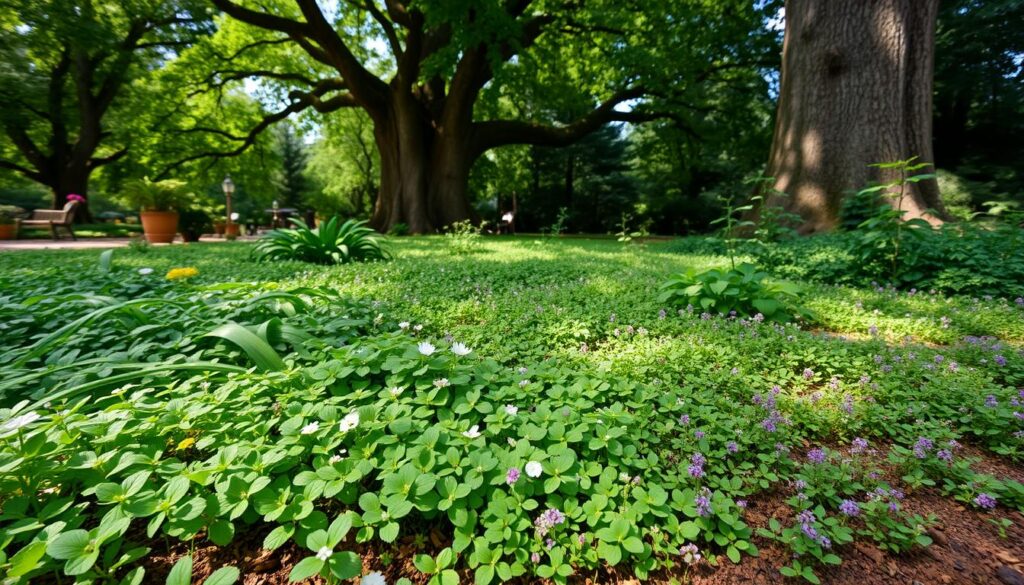
“The combination of ground covers and canopy trees is the foundation for building and maintaining healthy, fertile soil in a permaculture system.” – Permaculture Expert, Jane Doe
Managing Shade in Temperate Food Forests
In temperate climates, managing shade from canopy trees is key for a food forest’s success. Creating open, sunny glades and placing taller trees northward help. Pruning trees also controls shade levels.
Techniques for Maximizing Sunlight
Choosing shade-tolerant species for the understory and ground cover is another strategy. This careful planning ensures a balanced ecosystem. It boosts food production and tree health.
| Technique | Description |
|---|---|
| Open Glades | Creating sunny, open areas within the food forest to allow for the cultivation of sun-loving annuals and vegetables. |
| Positioning Tall Species | Placing taller trees and shrubs on the northern side of the food forest to minimize shading on the southern side. |
| North-South Paths | Establishing access paths that run in a north-south direction to maximize sunlight exposure. |
| Pruning | Carefully pruning trees and taller plants to regulate the degree of shade cast on lower-growing species. |
| Shade-Tolerant Species | Selecting understory and ground cover plants that thrive in partial shade conditions. |
Using these temperate food forest management methods, growers can create a thriving ecosystem. This ecosystem maximizes sunlight and minimizes shade’s negative effects.
Benefits of Canopy Trees
Environmental and Ecological Importance
Canopy trees are key in a permaculture system. They help fight climate change by capturing carbon dioxide. This makes the ecosystem healthier and more sustainable.
These trees also improve the local weather. They catch rain, block wind, and keep humidity levels up. This makes the area better for plants and animals, especially in harsh weather.
Canopy trees support many different life forms. From birds and mammals to insects and soil microbes, they offer a home. This diversity makes the ecosystem stronger and more resilient.
“Trees are the lungs of our land, purifying the air and giving fresh strength to our people.” – Franklin D. Roosevelt
In a permaculture system, canopy trees are vital. They help create a balanced and productive landscape. This supports a wide range of life and helps our planet.
Integrating Ground Covers and Canopy
Permaculture systems need ground cover plants and canopy trees to work together. Ground covers keep the soil healthy and fertile. Canopy trees control the weather and shade the area below. By picking the right plants and arranging them well, we can make a garden that’s like a natural forest.
It’s important to know how ground covers and canopy trees help each other. Ground covers stop weeds, keep water in, and make the soil richer. Canopy trees give shade, control the temperature, and help many insects and animals. Together, they make a system that’s stronger than each part alone.
- Ground covers protect the soil, keep moisture, and add organic matter
- Canopy trees control the weather, provide shade, and support biodiversity
- Putting ground covers and canopy trees in polycultures makes the system more productive and strong
Choosing the right ground cover and canopy tree species is key. This way, you can make a permaculture system that’s like nature. It’s not just good for your land. It also shows how important integration and complementary functions are in permaculture design.
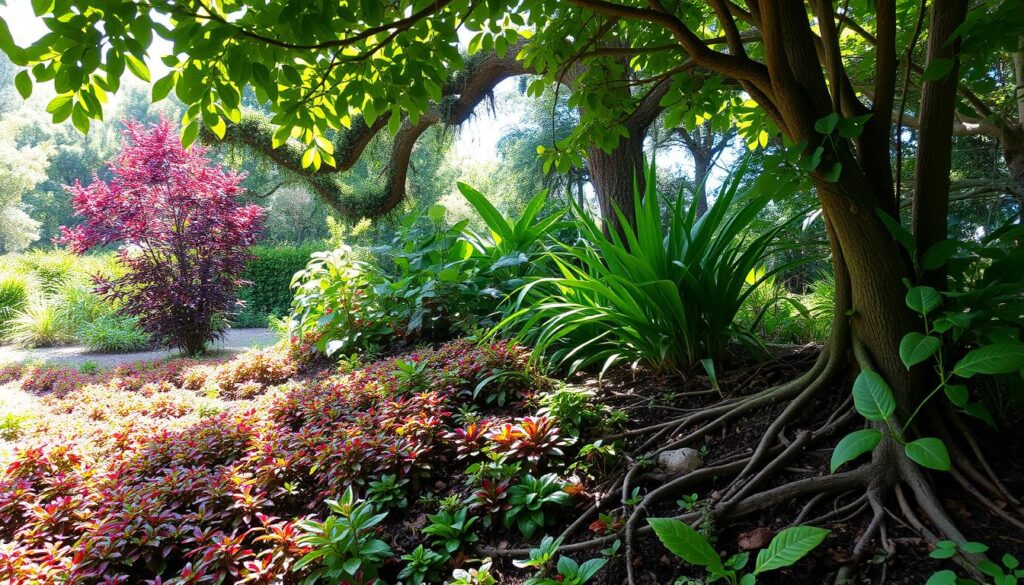
“By carefully integrating ground covers and canopy trees, we can create a self-sustaining, highly productive ecosystem that mimics the structure and functions of natural forests.”
Plant Guilds and Companion Planting
In permaculture, plant guilds are key to creating lush, sustainable gardens and food forests. A plant guild is a group of plants that help each other out. They work together, making the garden better for everyone.
By picking and placing plants with different jobs, like nitrogen-fixers and bug attractors, we can build polycultures. These synergistic relationships make the most of resources. They also boost the ecological functions of the whole garden.
“Sustainability is when your output exceeds your input.” – Bill Mollison, Co-founder of Permaculture
The Beacon Food Forest in Seattle is a great example. It’s a community project with a wide variety of plants. Each plant has at least six roles, making it a thriving, self-sustaining place.
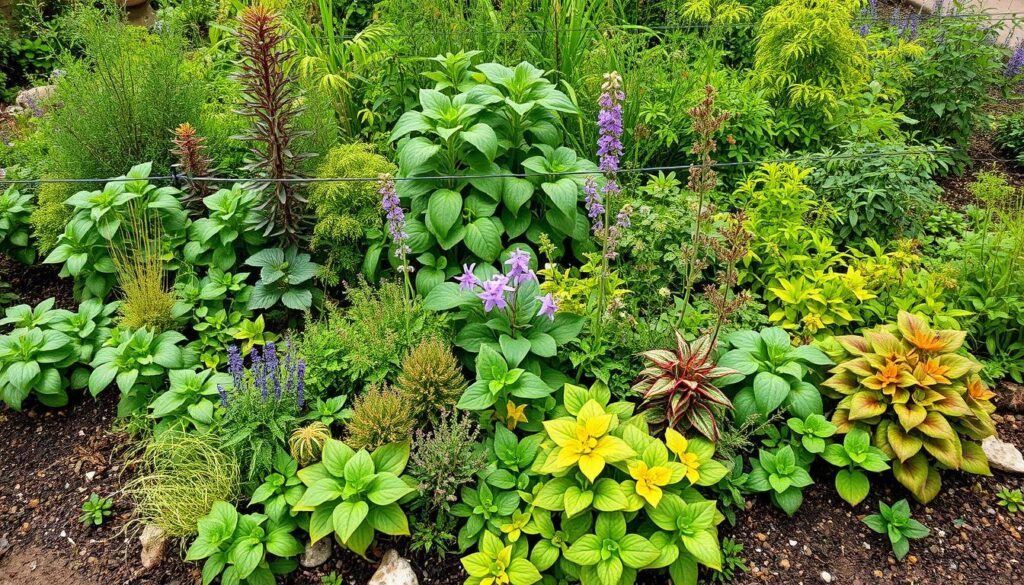
To make strong plant guilds, we need to understand the layers of a permaculture system. From the top canopy to the ground covers, each layer is important. By arranging these layers well, we can use companion planting to grow more, fight pests, and make our gardens stronger.
Bill Mollison said each element in a guild should have at least three roles. This way, the system is diverse and helps everyone. By using polycultures and synergistic relationships, we can make our land flourish. We create places that feed both people and the planet.
Selecting Suitable Permaculture Plants
Choosing the right plants is key to a successful permaculture system. You need to think about the climate, soil, and site conditions. Native plants usually do well here, needing less care and giving lots of food.
Considerations for Climate, Soil, and Site
Start by knowing your climate, soil, and site well. Look at things like drought tolerance, shade tolerance, and how plants grow. Pick plants that fit your area well to make a strong, easy-to-care-for permaculture garden.
- Check your climate’s temperature, rain, and frost to pick the right plants.
- Look at your soil’s pH, nutrients, and how it drains to find plants that will grow well.
- See how much sun your site gets, its slope, and any special spots for the best growing spots.
- Choose native species when you can, as they fit right into the local area.
“By selecting the right plants for your site, you can create a resilient, low-input permaculture system that provides abundant harvests.”
Using a mix of permaculture plants like ground covers, trees, and smaller plants makes a strong, self-supporting garden. Think about the climate adaptation, soil requirements, and site conditions to make sure your garden does well for a long time.
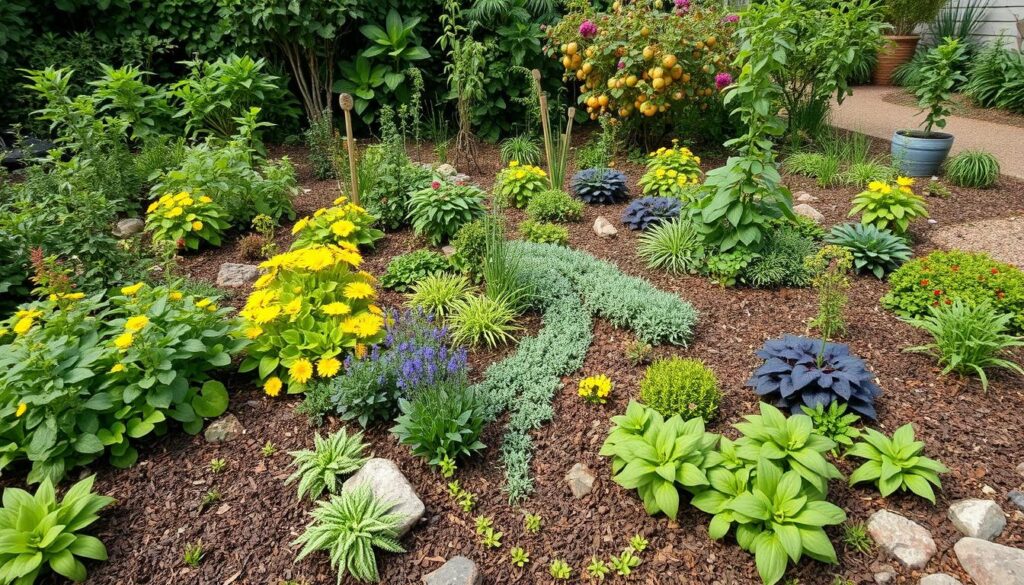
Maintaining and Nurturing Your Permaculture System
Keeping a permaculture system alive needs constant care. This means managing the permaculture maintenance of the soil. You can do this with mulching, composting, and supporting good bugs. Also, trimming and shaping plants helps them grow well. It’s important to watch for pests and diseases and use natural ways to control them.
Having the right tools is key for permaculture maintenance. You’ll need tools like hand trowels, garden forks, and pruning shears. Garden gloves, watering cans, and rakes are also important. These tools help with soil management, plant care, and pest and disease control.
Every season in a permaculture system has its tasks. In the spring, you prepare the soil and plant new things. You also watch for pests and weeds. In the summer, you focus on watering, mulching, and pruning. The fall is for harvesting and getting ready for winter. Winter is for protecting plants and planning for next year.
Regular care in permaculture gardening makes the garden work well together. This leads to stable growth and fewer problems. It makes the garden more resilient and productive over time.
| Season | Maintenance Tasks |
|---|---|
| Spring | Soil preparation, planting, transplanting, pest and weed monitoring |
| Summer | Watering, mulching, pruning, plant training |
| Fall | Harvesting, composting, cover crop planting, mulching perennials |
| Winter | Frost protection, planning for the next season |
Dedicated compost bins or piles are key for recycling organic matter. They help keep the soil rich and reduce waste. This makes the system more sustainable.
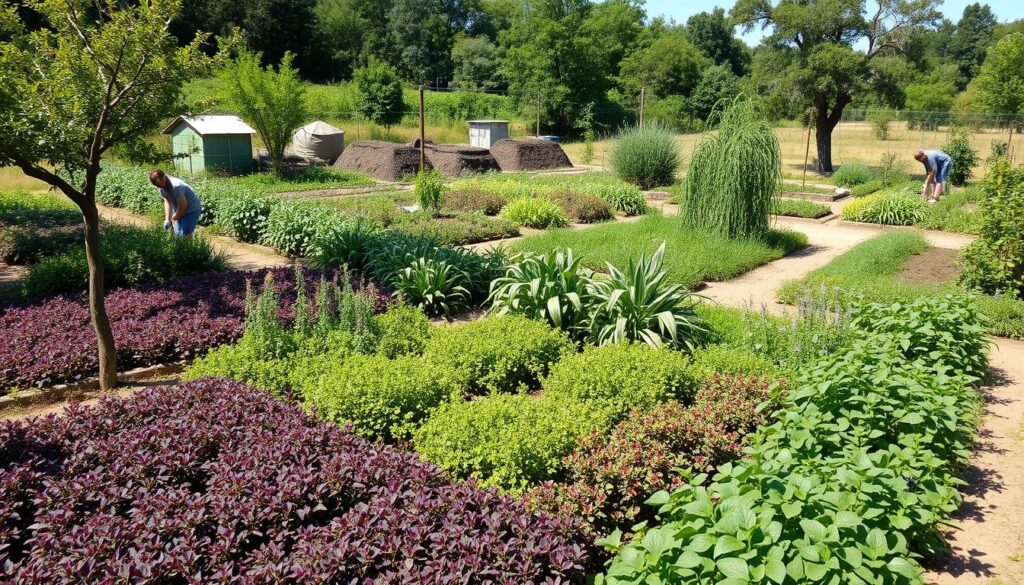
“Consistent care in permaculture gardening ensures that all elements of the garden work together in harmony, encouraging stable growth and minimizing potential issues.”
Conclusion
Permaculture plants are key to a thriving garden or food forest. They help create a self-sustaining ecosystem. By choosing the right plants and organizing them well, gardeners can enjoy plenty of food with little effort.
Starting a permaculture garden means loving the complex life within it. It’s about using ground covers, canopy trees, and layers to make a diverse and strong landscape. This way, we can grow food that’s good for us and the planet.
This guide is your first step to creating a permaculture garden. It’s a place where nature and humans live in harmony. By using permaculture plants, you can make a garden that’s not only beautiful but also helps our planet.

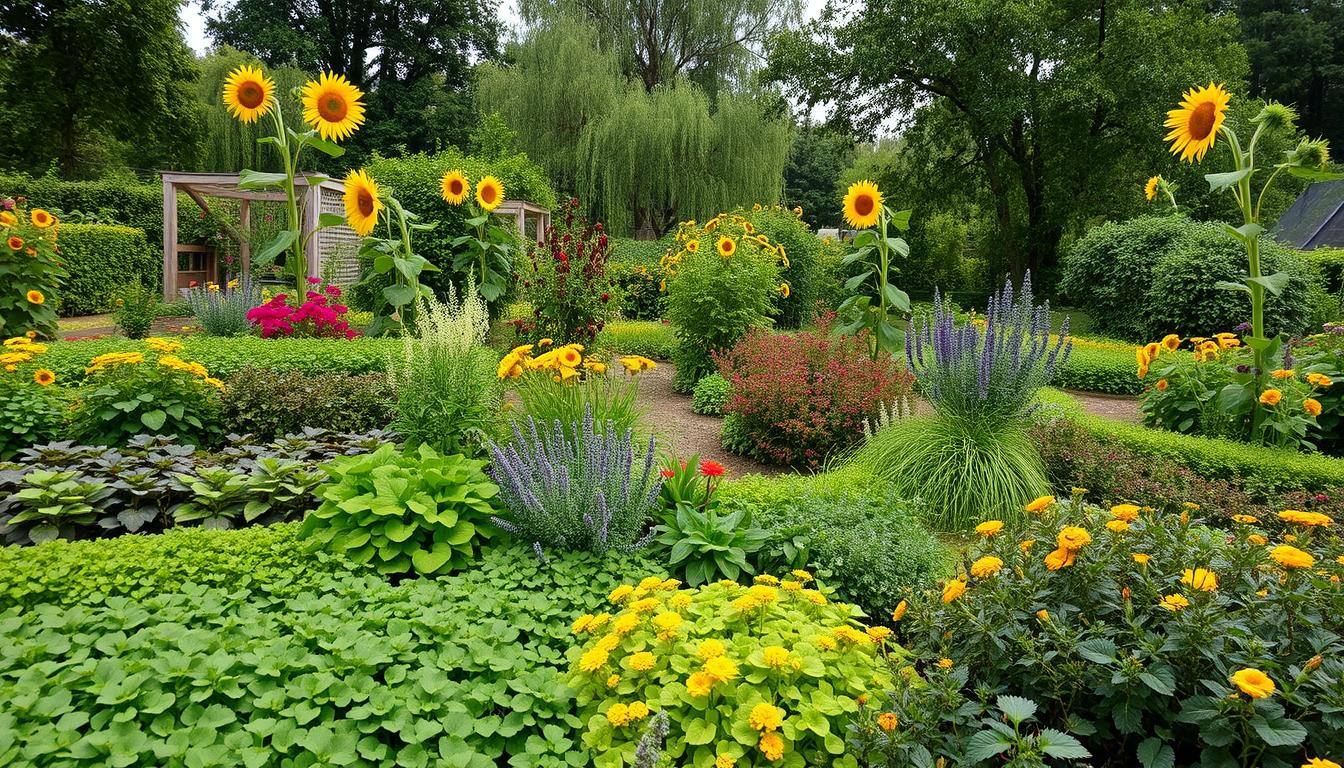
[…] conceptual difference is that Permaculturists are keyed into layering. By using different types of trees, bushes or shrubs, and cover crops within the cultivated space […]